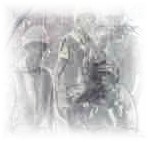Operation Deckhouse V 6-15 January 1967
The first SLF operation of 1967, Deckhouse V, was significant for two reasons. It was a sizable, combined U.S. Marine and Vietnamese Marine amphibious operation. More ominously, for the proponents of the SLF concept, it was the last SLF landing to take place beyond the boundaries of I Corps.
The ARG, under Captain John D. Westervelt, USN, with Colonel Harry D. Wortman's SLF embarked, steamed south to the coast of Kien Hoa Province in IV Corps for the landing. Deckhouse V was the only SLF operation for Major James L. Day's BLT 1/9 and it marked the end of SLF duty for Lieu tenant Colonel Marshall B. Armstrong's HMM-362.
D-day for Deckhouse V was 6 January. Both BLT 1/9 and elements of Vietnamese Marine Brigade Force Bravo, primarily consisting of the 3d and 4th Vietnamese Marine Battalions, enjoyed support throughout the operation from HMM-362's mixed force of UH-34 and CH-46 helicopters operating from the USS Iwo Jima (LPH 2). The combined seaborne and heliborne force assaulted an area of suspected Viet Cong concentrations on the coast between the Co Chien and Ham Luong reaches of the Mekong River. Lasting until 15 January, the operation produced unspectacular results. The combined force killed only 21 Viet Cong, destroyed two small arms workshops, and captured 44 weapons and 42 tons of rice. Seven U.S. Marines died and one Viet namese Marine died accidentally.
Some participants attributed Deckhouse V's failure to information leaks. The Marines en countered only local force VC in the operational area, but prisoners stated that larger VC units had been there before the landings. Someone told Captain Westervelt — he did not hear it himself— that a Philippine radio station broadcast the news when the ARG departed Subic Bay that the Marines were headed for the Mekong Delta.
Many other difficulties marred the execution of the combined operation. Communications were bad, rough seas interfered, planning was hurried, and on D plus 1 the 4th Battalion VNMC endured a near record-breaking ship-to-shore landing-craft move of 23 miles, rivaled only by some of the U.S. shore-to-shore operations in the Pacific during World War II. Captain Westervelt recalled these difficulties:
The Navy aspects of the Deckhouse V landings were formidable. Normal operating depths of water for the LPH, LED and other deep draft ships in the Amphibious Ready Group were about 8 to 10 miles to seaward off the coastal areas of Kien Hoa between the Co Chien and Ham Loung Rivers. The 8-inch gun cruiser Canberra had a fire support station some eight miles, as I recall, from the impact areas for her pre-assault bombardment. Water depths adequate for LST and rocket ship passage over the shallow bar into positions for the assault landings obtained only at high tide. Because an early morning landing time was required for the Marine assault forces in the LVT5 vehicles, this meant that, to protect the surprise features of the landings, the LST's and rocket ships had to proceed over the bar late in the preceding evening at high tide to be in position by dawn.
The long distance off-shore required by the principal ARG ships plus the fact that some landing beaches were well upstream from the seaward beaches accounted for the long boat rides (up to 23 miles) required for some of the troops.
The seas were very rough on the original D-Day (4 Jan) and again on 5 Jan, so the actual D-Day on 6 Jan was 2 days late. However, even on the 6th it was not possible to load the [Vietnamese Marines] from the Henrico into LCM6's alongside, so Henrico, Thomaston and Vancouver returned to Vung Tau, transferred Hennco's troops to the LED and LSD so loading could take place in the well decks. The [Vietanamese Marines] actually landed on the 7th.
The operation encountered problems at an even higher level. Amphibious doctrine called for the amphibious task force commander to control all aircraft in the amphibious operations area. Normally, these aircraft would come from the Navy and Marine Corps. The location of Deckhouse V created special circumstances, however, that dictated that all air support come from the Seventh Air Force. As Brigadier General John R. Chaisson later recalled, the commander of Seventh Air Force, Major General William W. Momyer, agreed with Navy control of aircraft in a traditional amphibious assault against a hostile shore. In the Mekong Delta, however, with the Air Force air control system already in place, General Momyer saw no valid reason to change the existing system just because an amphibious force temporarily was operating in the area. General Westmoreland backed the Navy in this argument in this case but all future SLF operations were to be in the I Corps area where such complicated command relationships could be avoided.'
PAUL MARQUIS WEB MASTER
SOURCE CITATION:
THE ABOVE OPERATIONS ARE CREDITED
TO 1/3 COMBAT HISTORY FILE AND THE BOOK, "SEMPER FI VIETNAM"

